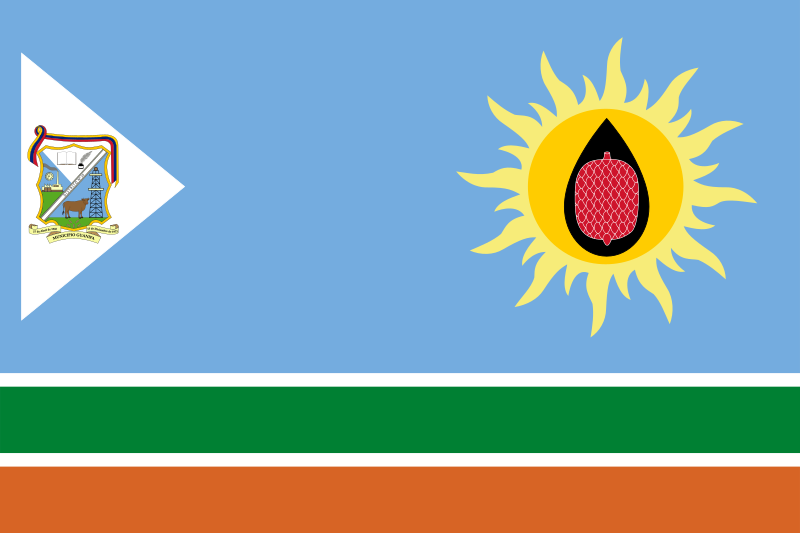Image: Bandera Municipio Guanipa

Description: Bandera del Municipio Guanipa La actual bandera del municipio Guanipa (Desde el año 2017), está dividida en cinco franjas horizontales de diferentes medidas, tres símbolos y siete colores que coinciden con los representados en el escudo de armas. Cada elemento simboliza una historia o leyenda ancestral natural y cultural del municipio. Franjas: • Azul: representa el agua y el cielo abierto, potencial de nuestro gentilicio para desarrollar sus culturas, vivencias, historias y creencias de nuestro río. • Verde: Representa nuestras sabanas, siembras, pastos, plantaciones de moriche, mango, merey entre otros frutos que abundan en la zona. • Rojo ladrillo: Representa las cobrizas y fértiles tierras donde habito la india Guanipa, el color de los farallones y casas de bahareque (hoy patrimonio cultural de nuestro municipio). • Blanco: Representa la paz mundial y Guanipa es territorio de paz. (Son dos Franjas horizontales, la primera ubicada entre las franjas Azul y verde y la segunda entre las franjas Verde y Rojo ladrillo). En el margen superior izquierdo un banderín blanco con el escudo de armas del municipio como gesto de amistad y bienvenida a los visitantes. Símbolos: • Amarillo: representado por el sol radiante, simboliza el entusiasmo de nuestra gente trabajadora que desde muy temprano salen a sus faenas. • Negro: representado por una gota de petróleo, principal materia prima de la Faja petrolífera del Orinoco, que fue convertida en leyenda caribe en honor a la princesa Caribe IT-CHE-ME, pionera en el progreso de la región dando cavidad a las sucesivas industrias en nuestro municipio. • Rojo: representado por un moriche, totem símbolo de la mesa de Guanipa, guardián de nuestros ríos y bosques, fruto de la cadena alimenticia Caribe, sus palmas utilizadas para la protección del sol y la lluvia en sus bahareques, el color rojo representa la sangre heroica ancestral derramada en batallas por nuestros indígenas que defendieron su territorio.
Title: Bandera Municipio Guanipa
Credit: Own work, No machine-readable source provided. Own work assumed (based on copyright claims).
Author: Unknown authorUnknown author
Permission: This image is in public domain in Venezuela because in accordance with: Law on Copyright of 14 August 1993, Articles 4, 25, 26, 27, 28, 38 and 59:The texts of laws, decrees, official regulations, public treaties, judicial decisions and other official acts shall not be protected by this Law. The right of exploitation of a created audiovisual work, a broadcast work or a computer program by the author and his/her successors expires after 60 years, counted from 1 January of the year following from the first publication. Copyright shall subsist for the lifetime of the author and shall expire after 60 years counted from 1 January of the year following his death, including the copyright in works not disclosed in his lifetime. It is a collaborative work, and sixty years have passed counting from 1 January of the year following that of the death of the last surviving coauthor. The copyrights of a photographer and his/her successors become extinct sixty years from the first publication of the work. Sixty years have passed since the work's completion and it was not published or registered during this period. The time referred to for purposes of copyright is counted from 1 January of the year following the publication or, failing that, the completion. It is an anonymous or pseudonymous work, and sixty years have passed from the first publication or the completion of the work. It is a photo made by a professional photographer, and it was a an object where ownership transferred during a labor relationship or professional contract and the employer or contractor liberated it. It is an edition of a work of others or of texts that represent the result of scientific work, and fifteen years have passed since the publication of the work or the preparation of the work (whichever comes first). This does not affect the period of copyright of the original work. It is an image recorded on audiovisual tape, and equivalent conditions to copyright of photographs have been met, insofar as they do not themselves constitute audiovisual works. Ley Orgánica del Trabajo, los Trabajadores y las Trabajadoras (Labor Law), on May 7, 2012, Article 325Intellectual products generated under an employment relationship in the public sector—or financed through public funds—that generates intellectual property rights, will be considered to be in the public domain, while maintaining the authors' rights to public recognition.
Usage Terms: Public domain
License: Public domain
Attribution Required?: No
Image usage
The following page links to this image:

